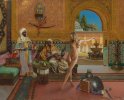Rudolf Ernst (1854-1932) was an Austro-French painter, printmaker and ceramics designer, who specialised in Orientalist themes, depicting mosques, harems and everyday life in North Africa. He travelled through Spain, Morocco, Egypt and Istanbul to observe his subjects at first hand. The same characters and figure poses appear in numerous different paintings, suggesting that whilst the environments are developed from studies made on location, they are populated by models posed in his Paris studio.
Kam's background source is entitled, 'Two Warriors in the Alhambra Palace, the Court of Lions in the background', which carried an estimate of around half a million pounds sterling when offered in Christie's sale in April 2019 (I do not know the final figure realised at auction). The painting is in oil on a wooden panel, measuring 23 ¼ x 28 ¾ in. This is relatively small considering the level of detail, and in fact Kam's picture expands to larger than actual size with no compromise in clarity. This is a highly detailed painting, full of rich fabrics and furnishings, rendered in brilliant colours and realistic textures.
The seated male evidently stood on the sofa to hang his sabre and dagger from the hook, high up on the wall. He can reach the weapons if needed in a hurry, but now he is preoccupied with a 'relaxing' smoke on his elaborate pipe. His friend is obviously much shorter, and would never have reached the hook, so he is content to wear his sword, stuck through his belt, which is becoming slightly frayed from precisely this habit. Eschewing the pleasures of the pipe, he drinks a cup of tea instead, and now gazes appreciatively at Kam's new model.
The original foreground contains a large area of empty, pink-coloured carpet, which seems to be calling out for a third figure in the composition. Kam has obliged the viewer by providing Keigera's character, dancing elegantly, and captured here in a charming cruciform pose. She is the only inserted component, together with her separately applied, decorative ankle bracelet and the appropriate shadows at her feet, painted subtly to blend with the carpet. Kam has declined to add his motif on this occasion, deferring to the signature of the original artist at lower right.
This is a very neat example of blending, using a figure which has been extracted with commendable precision, and inserted in a manner which is sympathetic to the original work. The lighting and scale of the figure appear consistent with the interior scene, and she is being directly observed by the standing male on the left. Kam will probably insist, with typical modesty, that this is a very quick and simple illustration to Keigera's dramatic story, notwithstanding the degree of care taken over the matching of a compatible figure and background. Yet again, I am unable to identify the model (is this Delizi again?) Nevertheless, this is another excellent collaboration between artist and writer, and a very fine manipulation. Well done, Kam!












